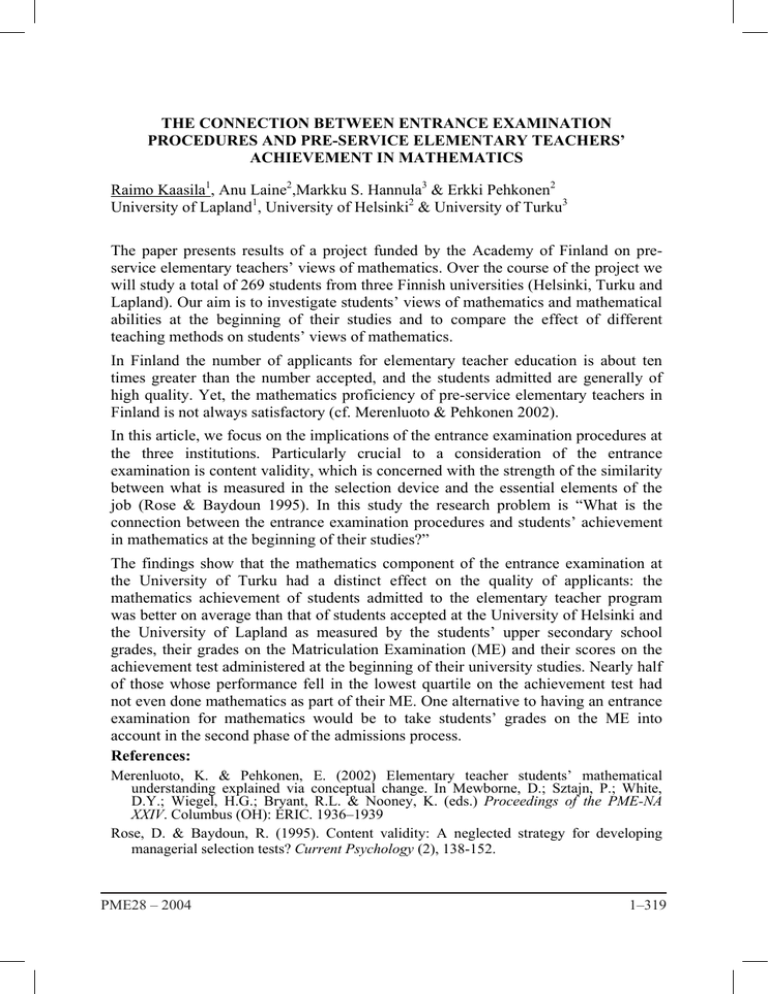THE CONNECTION BETWEEN ENTRANCE EXAMINATION PROCEDURES AND PRE-SERVICE ELEMENTARY TEACHERS’
advertisement

THE CONNECTION BETWEEN ENTRANCE EXAMINATION PROCEDURES AND PRE-SERVICE ELEMENTARY TEACHERS’ ACHIEVEMENT IN MATHEMATICS Raimo Kaasila1, Anu Laine2,Markku S. Hannula3 & Erkki Pehkonen2 University of Lapland1, University of Helsinki2 & University of Turku3 The paper presents results of a project funded by the Academy of Finland on preservice elementary teachers’ views of mathematics. Over the course of the project we will study a total of 269 students from three Finnish universities (Helsinki, Turku and Lapland). Our aim is to investigate students’ views of mathematics and mathematical abilities at the beginning of their studies and to compare the effect of different teaching methods on students’ views of mathematics. In Finland the number of applicants for elementary teacher education is about ten times greater than the number accepted, and the students admitted are generally of high quality. Yet, the mathematics proficiency of pre-service elementary teachers in Finland is not always satisfactory (cf. Merenluoto & Pehkonen 2002). In this article, we focus on the implications of the entrance examination procedures at the three institutions. Particularly crucial to a consideration of the entrance examination is content validity, which is concerned with the strength of the similarity between what is measured in the selection device and the essential elements of the job (Rose & Baydoun 1995). In this study the research problem is “What is the connection between the entrance examination procedures and students’ achievement in mathematics at the beginning of their studies?” The findings show that the mathematics component of the entrance examination at the University of Turku had a distinct effect on the quality of applicants: the mathematics achievement of students admitted to the elementary teacher program was better on average than that of students accepted at the University of Helsinki and the University of Lapland as measured by the students’ upper secondary school grades, their grades on the Matriculation Examination (ME) and their scores on the achievement test administered at the beginning of their university studies. Nearly half of those whose performance fell in the lowest quartile on the achievement test had not even done mathematics as part of their ME. One alternative to having an entrance examination for mathematics would be to take students’ grades on the ME into account in the second phase of the admissions process. References: Merenluoto, K. & Pehkonen, E. (2002) Elementary teacher students’ mathematical understanding explained via conceptual change. In Mewborne, D.; Sztajn, P.; White, D.Y.; Wiegel, H.G.; Bryant, R.L. & Nooney, K. (eds.) Proceedings of the PME-NA XXIV. Columbus (OH): ERIC. 1936–1939 Rose, D. & Baydoun, R. (1995). Content validity: A neglected strategy for developing managerial selection tests? Current Psychology (2), 138-152. PME28 – 2004 1–319





